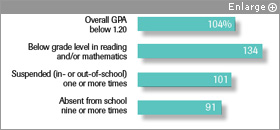Dropout Indicators Found for 1st Graders
By Sarah D. Sparks - Education Week
As tracking data on students grow ever more extensive, some Maryland educators are finding that the early-warning signs of a student at risk of dropping out may become visible at the very start of their school careers.
The affluent and tech-savvy 149,000-student Montgomery County public schools, in a suburb of Washington, is building one of the first early-warning systems in the country that can identify red flags for 75 percent of future dropouts as early as the second semester of 1st grade.
“It’s a very sobering point, but I take it as an opportunity: If these kids are always with us, we can do something about this,” said Thomas “Chris” C. West, Montgomery County’s evaluation specialist, who built the tracking formula. “Remember, these are signs of students who drop out—it doesn’t mean they are dropouts.”
Montgomery County’s initiative comes in the midst of an explosion in the use of longitudinal data systems to identify students at risk of not graduating from high school on time. According to the most recent count by the Data Quality Campaign![]() , for 2012, 28 states use early-warning systems, with more in development. These systems can be used to target interventions based on profiles of characteristics of students who fail academically and drop out of school, though at this point, relatively few states or districts have reports available to principals and teachers multiple times a year.
, for 2012, 28 states use early-warning systems, with more in development. These systems can be used to target interventions based on profiles of characteristics of students who fail academically and drop out of school, though at this point, relatively few states or districts have reports available to principals and teachers multiple times a year.
Knowing the District
As early as 1st grade, factors such as reading below grade level or racking up more than nine absences in a year can exponentially increase the odds that a students will eventually drop out of school, according to Montgomery County’s data.
Most modern early-warning systems have evolved out of the work of Robert Balfanz, the co-director of the Everyone Graduates Center and a research scientist at the Center for Social Organization of Schools at Johns Hopkins University in Baltimore and from the University of Chicago Consortium on Chicago School Research. Research from the Johns Hopkins center showed that three red flags—chronic absenteeism, severe disciplinary infractions, and reading or mathematics failures—signal a student’s disengagement from school and predict his or her risk of dropping out as early as 6th grade.
Other studies have since replicated the findings at younger and younger grades. However, Mr. West, who is also affiliated with Mr. Balfanz, cautioned that researchers and educators must study these risk factors in the context of a specific school system.
The Montgomery County district compared the grades, attendance, and behavior of 723 dropouts from the class of 2011 and 523 dropouts from the class of 2012 with those of their classmates who graduated. The early-warning system reverse-engineers a risk profile based on warning signs at four critical transition points: spring of 1st grade and fall of 3rd, 6th, and 9th grades.
For example, chronic absenteeism is generally defined as missing 10 percent or more days of school, excused or unexcused. In Montgomery County, Mr. West found virtually no pupils in the early-elementary grades missed 20 days of school. But missing as few as nine days of school nearly doubled a student’s risk of dropping out later.
“The message for Montgomery County is, our kids are there in school; they just aren’t doing well,” Mr. West said at a discussion of the data system at the National Center on Education Statistics’ annual conference in Washington this month.
Similarly, elementary schools very rarely handed out punishments as severe as suspensions, but more subtle behavior cues, such as report card notations of incomplete homework, more accurately signaled future problems for elementary children.
Report card grades proved to be the strongest predictor of dropout risk found in grades 1 and 3. An overall GPA of 1.2 (roughly a D) in the spring of 1st grade more than doubled a student’s risk of dropping out later on, and more specifically, reading or doing math below grade level in 1st grade increased dropout risk by 134 percent.


